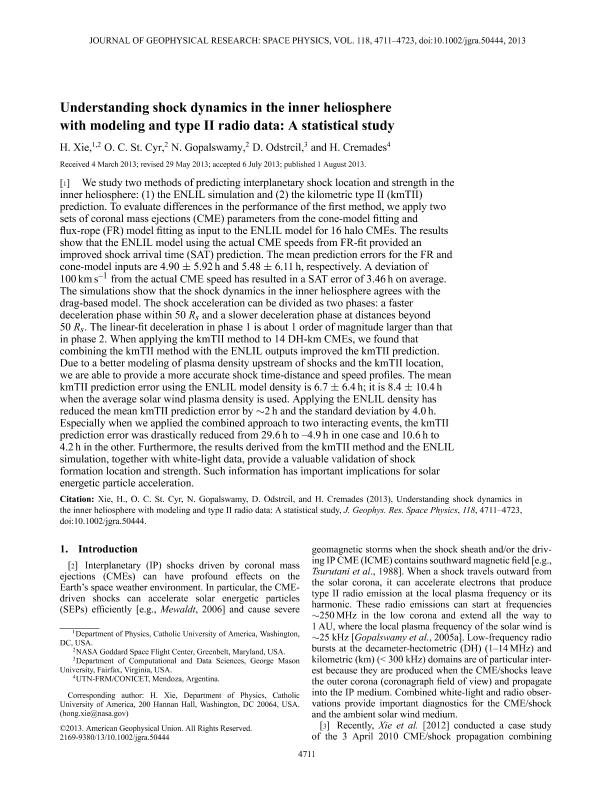Mostrar el registro sencillo del ítem
dc.contributor.author
Xie, H.
dc.contributor.author
St. Cyr, O.C.
dc.contributor.author
Gopalswamy, N.
dc.contributor.author
Odstrcil, D.
dc.contributor.author
Cremades Fernandez, Maria Hebe

dc.date.available
2016-09-05T18:41:03Z
dc.date.issued
2013-08
dc.identifier.citation
Xie, H.; St. Cyr, O.C.; Gopalswamy, N.; Odstrcil, D.; Cremades Fernandez, Maria Hebe; Understanding shock dynamics in the inner heliosphere with modeling and type II radio data: A statistical study; American Geophysical Union; Journal Of Geophysical Research: Space Physics; 118; 8; 8-2013; 4711-4723
dc.identifier.issn
0148-0227
dc.identifier.uri
http://hdl.handle.net/11336/7450
dc.description.abstract
We study two methods of predicting interplanetary shock location and strength in the inner heliosphere: (1) the ENLIL simulation and (2) the kilometric type II (kmTII) prediction. To evaluate differences in the performance of the first method, we apply two sets of coronal mass ejections (CME) parameters from the cone-model fitting and flux-rope (FR) model fitting as input to the ENLIL model for 16 halo CMEs. The results show that the ENLIL model using the actual CME speeds from FR-fit provided an improved shock arrival time (SAT) prediction. The mean prediction errors for the FR and cone-model inputs are 4.90±5.92 h and 5.48±6.11 h, respectively. A deviation of 100 km s−1 from the actual CME speed has resulted in a SAT error of 3.46 h on average. The simulations show that the shock dynamics in the inner heliosphere agrees with the drag-based model. The shock acceleration can be divided as two phases: a faster deceleration phase within 50 Rs and a slower deceleration phase at distances beyond 50 Rs. The linear-fit deceleration in phase 1 is about 1 order of magnitude larger than that in phase 2. When applying the kmTII method to 14 DH-km CMEs, we found that combining the kmTII method with the ENLIL outputs improved the kmTII prediction. Due to a better modeling of plasma density upstream of shocks and the kmTII location, we are able to provide a more accurate shock time-distance and speed profiles. The mean kmTII prediction error using the ENLIL model density is 6.7±6.4 h; it is 8.4±10.4 h when the average solar wind plasma density is used. Applying the ENLIL density has reduced the mean kmTII prediction error by ∼2 h and the standard deviation by 4.0 h. Especially when we applied the combined approach to two interacting events, the kmTII prediction error was drastically reduced from 29.6 h to −4.9 h in one case and 10.6 h to 4.2 h in the other. Furthermore, the results derived from the kmTII method and the ENLIL simulation, together with white-light data, provide a valuable validation of shock formation location and strength. Such information has important implications for solar energetic particle acceleration.
dc.format
application/pdf
dc.language.iso
eng
dc.publisher
American Geophysical Union

dc.rights
info:eu-repo/semantics/openAccess
dc.rights.uri
https://creativecommons.org/licenses/by-nc-sa/2.5/ar/
dc.subject
Coronal Mass Ejection
dc.subject
Interplanetary Shock
dc.subject
Enlil Model
dc.subject
Type Ii Burst
dc.subject.classification
Astronomía

dc.subject.classification
Ciencias Físicas

dc.subject.classification
CIENCIAS NATURALES Y EXACTAS

dc.title
Understanding shock dynamics in the inner heliosphere with modeling and type II radio data: A statistical study
dc.type
info:eu-repo/semantics/article
dc.type
info:ar-repo/semantics/artículo
dc.type
info:eu-repo/semantics/publishedVersion
dc.date.updated
2015-10-15T19:43:14Z
dc.journal.volume
118
dc.journal.number
8
dc.journal.pagination
4711-4723
dc.journal.pais
Estados Unidos

dc.journal.ciudad
Hoboken
dc.description.fil
Fil: Xie, H.. NASA. Goddard Space Flight Center; Estados Unidos. Department of Physics. Catholic University of America; Estados Unidos
dc.description.fil
Fil: St. Cyr, O.C.. NASA. Goddard Space Flight Center; Estados Unidos
dc.description.fil
Fil: Gopalswamy, N.. NASA. Goddard Space Flight Center; Estados Unidos
dc.description.fil
Fil: Odstrcil, D.. George Mason University. Department of Computational and Data Sciences; Estados Unidos
dc.description.fil
Fil: Cremades Fernandez, Maria Hebe. Consejo Nacional de Investigaciones Científicas y Técnicas; Argentina. Universidad Tecnológica Nacional. Facultad Regional de Mendoza; Argentina
dc.journal.title
Journal Of Geophysical Research: Space Physics
dc.relation.alternativeid
info:eu-repo/semantics/altIdentifier/doi/http://dx.doi.org/10.1002/jgra.50444
dc.relation.alternativeid
info:eu-repo/semantics/altIdentifier/url/http://onlinelibrary.wiley.com/doi/10.1002/jgra.50444/abstract
Archivos asociados
